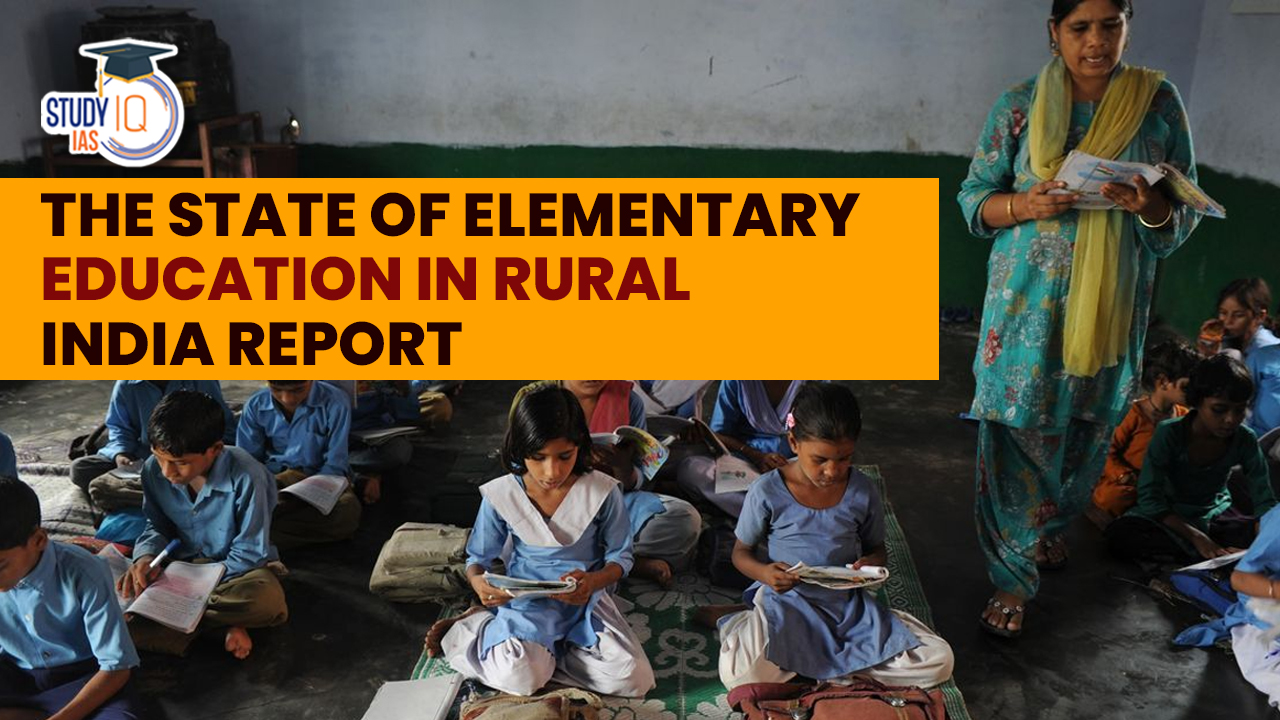Table of Contents
Context: Delhi-based Development Intelligence Unit (DIU), an initiative of Transforming Rural India Foundation (TRIF) has launched a report titled the ‘state of elementary education in rural India-2023’.
About the Report
- The report gathered responses from 6,229 parents, including those with school-going students, dropouts, and children who had never enrolled in school.
- The study was focused on 6 to 16-year-old children in rural communities across 20 states in India.
Key Finding of the Report
- Gender inclusivity: The report noted that parents from rural communities firmly believe that a child’s gender, whether a boy or a girl, should not hinder their educational aspirations.
- In this study, it was revealed that a total of 78 per cent of parents of girls and 82 per cent of parents of boys wanted to educate their children to graduation and above.
- Increased access to smartphones: Nearly half, 49.3 percent of students in rural India have access to smartphones.
- However, a significant portion, 76.7 percent of these students primarily use their phones for entertainment purposes, such as playing video games and watching movies.
- Only 34 percent of smartphone-accessible students use their devices for study-related downloads, while 18 percent access online learning through tutorials.
- Learning environment at home: The survey revealed that 40 percent of parents have age-appropriate reading materials available at home, beyond schoolbooks.
- Additionally, only 40 percent of parents engage in daily conversations with their children about their school learning, while 32 percent have such discussions a few days a week.
- Reasons for dropout and out-of-school children: Among the parents of 56 students who dropped out of school, 36.8 percent mentioned that their daughters’ dropout was due to the need to contribute to the family’s earnings.
- For boys, the primary reason for dropping out was lack of interest in studies, cited by 71.8 percent of parents.
- Parental participation: A positive aspect observed was that 84 percent of parents regularly attend parent-teacher meetings, demonstrating their active involvement in their children’s education.

Why is it important to educate rural India?
- Growth of Agriculture: As per the census 2011, about 54.6% of the country’s population was engaged in agriculture and allied activities. Out of these, about of 70% the total rural households were involved in agricultural activities; 82% of them being small and marginal farmers making it the largest source of livelihood in India. Thus, by improving rural education, agriculture sector can grow a lot with new technologies and knowledge.
- Growth of MSME Sector: Micro, Small and Medium Enterprises (MSME) sector is a huge contributor to the Indian economy making up about 30% of the country’s GDP. With the sector employing about 50 million people in rural India, it is one of the most important sectors in the rural economy. Hence, education is important for the growth of the MSME sector.
Indian Rural Education Challenges
- Inadequate number of schools: The limited number of schools in rural areas creates a major barrier to education.
- Poverty: Poverty remains a significant obstacle to education in rural India. Many families lack the financial resources to afford schooling for their children, and private schools are often out of reach due to their high costs.
- Bad Infrastructure: Poor infrastructure in rural schools, including inadequate teacher-student ratios and lack of basic amenities like textbooks, drinking water, and libraries, undermines the quality of education. The absence of essential facilities hampers effective learning and teaching.
- Traditional Teaching Methods: While urban schools have embraced modern teaching techniques, rural schools often rely on traditional methods. This outdated approach to education can hinder students’ critical thinking skills and engagement with the subject matter.
- Lack of Technology: In the 21st century, basic computer literacy is crucial for every child’s future prospects. However, many rural schools lack access to technology and computer education, contributing to a digital divide that limits opportunities for rural students.
- Rural-Urban Divide: The disparity between rural and urban education systems extends beyond infrastructure. Variations in teaching methods, subjects taught, and the quality of education create a substantial divide between rural and urban learners.
- Parents’ Ignorance: High dropout rates in rural schools, particularly before completing the 12th grade, often stem from parents’ lack of awareness about the importance of education and their limited understanding of its long-term benefits.
Government initiatives for rural education
| Samagra Shiksha |
|
| Shiksha Karmi Project |
|
| Lok Jambish Pariyojana |
|
| Digital initiatives |
|
Way Forward
- Equitable Resource Allocation: Allocate resources equitably across rural schools to bridge the gap between urban and rural education facilities. This includes providing textbooks, teaching materials, and necessary infrastructure.
- Digitalization of Education: Integrate technology into education by providing e-resources and online courses. Digital literacy is crucial in a technology-driven world, and it can improve access to quality educational materials, especially in remote areas.
- Community Engagement: Involve parents, community members, and local leaders in supporting education initiatives. Building a strong community partnership can foster a sense of ownership and responsibility for the quality of education.
- Inclusive Education: Implement measures to ensure education is accessible and inclusive for all, including children with disabilities or from marginalized communities.


 New Window of Opportunity for India amid...
New Window of Opportunity for India amid...
 Cetacean Morbillivirus: Meaning, Feature...
Cetacean Morbillivirus: Meaning, Feature...
 Acid Attacks in India: Causes, Laws, Sta...
Acid Attacks in India: Causes, Laws, Sta...

























